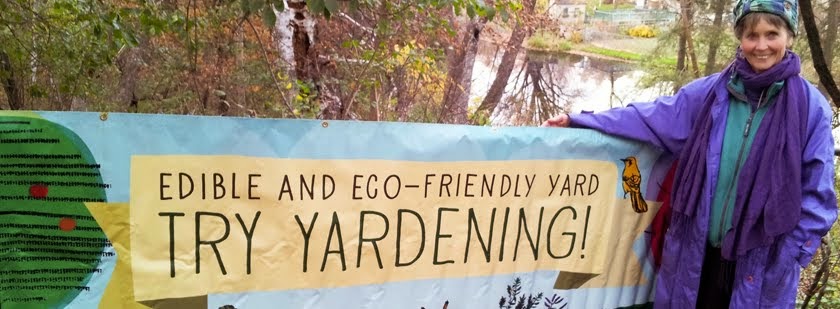Convert a resource-guzzling lawn into a lovely, money-saving edible landscape.
In addition to being a viable design
option, an edible landscape (if maintained organically) is the most
compelling landscape concept for the future.
Edible landscapes offer these incredible benefits:
Energy Savings: Food from your yard requires no shipping and little refrigeration. Plus, conventional farms use a large amount of energy to plow, plant, spray and harvest produce—planting and picking tomatoes in your front yard requires a miniscule amount by comparison.
Food Safety: You know which chemicals (if any) you use.
Water Savings: Tests show that most home gardeners use less than half the water to produce the same crop compared with large-scale agricultural production. Drip irrigation saves even more.
Money Savings: You can grow an unbelievable amount of food in a small, beautiful space. When I meticulously calculated the value of a 100-square-foot edible landscape I grew a couple of summers ago, I was amazed to find it had saved me more than $700! (Visit rosalindcreasy.com for exact figures for some popular crops.)
Better Nutrition: Fully ripe, just-picked, homegrown fruits and vegetables provide more vitamins and nutrients than supermarket produce, which is usually picked under-ripe and is days or weeks old when you eat it.
Designing Your Edible Landscape
Any landscape design begins with establishing the “bones” of your garden—choosing the location of the paths, patios, fences, hedges, arbors and garden beds. This is critically important in an edible garden because the beds are more apt to have plants with a wide array of textures, sizes and shapes, such as curly carrot leaves, mounding peppers and climbing beans. Edible garden beds may be filled with young seedlings or even be empty at times. That’s when paths, arbors, fences, hedges and even a birdbath are vital for keeping things attractive.
After you’ve determined the setup of the landscape, it’s time to choose the plants. Herein lies the true subtlety of the landscaper’s art. First, make a list of edibles you like most. Find out which ones grow well in your climate, and note their cultural needs. Our sister publication Mother Earth News offers a searchable list of plant recommendations and planting times, organized by region.
Edible landscapes offer these incredible benefits:
Energy Savings: Food from your yard requires no shipping and little refrigeration. Plus, conventional farms use a large amount of energy to plow, plant, spray and harvest produce—planting and picking tomatoes in your front yard requires a miniscule amount by comparison.
Food Safety: You know which chemicals (if any) you use.
Water Savings: Tests show that most home gardeners use less than half the water to produce the same crop compared with large-scale agricultural production. Drip irrigation saves even more.
Money Savings: You can grow an unbelievable amount of food in a small, beautiful space. When I meticulously calculated the value of a 100-square-foot edible landscape I grew a couple of summers ago, I was amazed to find it had saved me more than $700! (Visit rosalindcreasy.com for exact figures for some popular crops.)
Better Nutrition: Fully ripe, just-picked, homegrown fruits and vegetables provide more vitamins and nutrients than supermarket produce, which is usually picked under-ripe and is days or weeks old when you eat it.
Designing Your Edible Landscape
Any landscape design begins with establishing the “bones” of your garden—choosing the location of the paths, patios, fences, hedges, arbors and garden beds. This is critically important in an edible garden because the beds are more apt to have plants with a wide array of textures, sizes and shapes, such as curly carrot leaves, mounding peppers and climbing beans. Edible garden beds may be filled with young seedlings or even be empty at times. That’s when paths, arbors, fences, hedges and even a birdbath are vital for keeping things attractive.
After you’ve determined the setup of the landscape, it’s time to choose the plants. Herein lies the true subtlety of the landscaper’s art. First, make a list of edibles you like most. Find out which ones grow well in your climate, and note their cultural needs. Our sister publication Mother Earth News offers a searchable list of plant recommendations and planting times, organized by region.
Read more: http://www.motherearthliving.com/gardening/eat-your-yard-edible-landscape.aspx#ixzz3NLEc9MSP
Read more: http://www.motherearthliving.com/gardening/eat-your-yard-edible-landscape.aspx#ixzz3NLFJEyzI

No comments:
Post a Comment